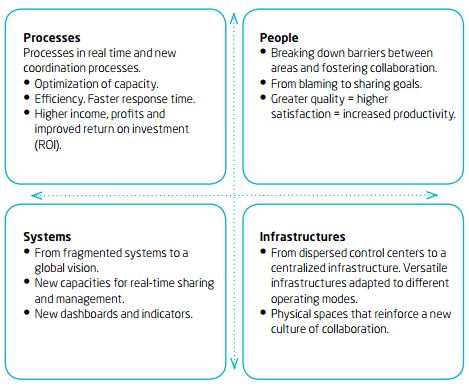Context
Modernization of AAI infrastructures using state-of-the-art technology
The Airports Authority of India (AAI) planned the modernization of Delhi's air control center, one of the most important centers in the country, which manages one of the busiest air traffic areas in India, including operations in Indira Gandhi international airport (New Delhi).
The surveillance area covered by these systems corresponds to 80% of the Indian air space, a very high percentage. This coverage increases security and the capacity for air traffic management, reducing costs.
Airports must enhance their dynamic nature and must involve all actors through collaboration and continuous improvement, sharing goals and increasing flexibility.
The AAI faced the enormous challenge of managing and maximizing the benefits obtained of greater operating complexity based on a new concept of Airport Management Center (AMC), an essential tool.
The AMC is the meeting point for this new shared focus, allowing for global improvements. Here is where the airport's different areas come together to work, overcoming previously existing institutional barriers, including external actors and Air Navigation, to together manage and resolve problems in real time.
Proposed solution
Airport Management Center (AMC)
Indra has a broad experience in the design of control centers, highlighting two different implementations of the AMC concept. The same AMC model can never be copied. An AMC is only useful if it is in full harmony with an airport's operating model, including its goals, resources and environment. For this reason, whether in Europa or in Asia, the AMC concept must adapt to different business models, cultures and work methods.
The AMC is much more than a control room. Its design is based on an airport's processes, providing each department's managers and roles clarity.
Improved visibility and traceability. Key indicators and new coordination processes are defined, based on collaboration.
The Delhi center was designed with enough flexibility for it to support multiple work configurations: at peak times, during reduced operations or in emergencies. Furthermore, its scalable design guarantees future growth.
Information systems are aligned with AMC requirements, making sure the systems adapted to the new way of working and preventing the former's conditioning of the latter.
Technological integration of systems guaranteed that any application could generate an alarm or image, in real time, to the correct console or corresponding section of the video wall.
Benefits
Improved process and systems management
- Coordination of actors. Improved horizontal and vertical communications
- Providing information for better decisionmaking
- Offering operational improvements to increase performance
- Improved hub operations
- Optimized resource management
- Improved passenger experience
- Impact on cost containment
- Capacity for crisis management using key information and involving the affected actors
- Prepared for the future: adapted to the SESAR APOC concept

